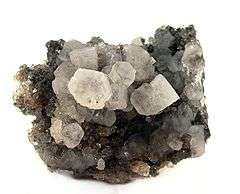Aphthitalite
| Aphthitalite | |
|---|---|
|
Aphthitalite, collected from Ghom Salt Dome, Qom Province, Iran | |
| General | |
| Category | Sulfate mineral |
| Formula (repeating unit) | (K,Na)3Na(SO4)2 |
| Strunz classification | 7.AC.35 |
| Crystal system | Trigonal |
| Crystal class |
Hexagonal scalenohedral (3m) H-M symbol: (3 2/m) |
| Space group | P3m |
| Unit cell | a = 5.67, c = 7.33 [Å]; Z = 1 |
| Identification | |
| Color | White, colorless; gray, blue, green due to inclusions and impurities |
| Crystal habit | Tabular crystals (with distorted pseudo-orthorhombic habit); as bladed aggregates and in crusts |
| Twinning | On {0001} or repeated on {1120} |
| Cleavage | Fair on {1010}, poor on {0001} |
| Fracture | Conchoidal to uneven |
| Tenacity | Brittle |
| Mohs scale hardness | 3 |
| Luster | Vitreous to resinous |
| Diaphaneity | Transparent to opaque |
| Specific gravity | 2.66–2.71 |
| Optical properties | Uniaxial (+) (anomalously biaxial) |
| Refractive index | nω = 1.487 - 1.491 nε = 1.492 - 1.499 |
| Birefringence | δ = 0.005 |
| Solubility | In water |
| References | [1][2][3] |
Aphthitalite is a potassium sulfate mineral with the chemical formula: (K,Na)3Na(SO4)2.
It was first described in 1835 for an occurrence on Mt. Vesuvius, Italy. The name is from the Greek άφθητος, "unalterable", and άλας, "salt", for its stability in air.[1] It occurs as fumarolic incrustations in volcanic environments, as small crystals and masses in evaporite deposits and in guano deposits.[2][3] It occurs associated with thenardite, jarosite, sylvite and hematite in fumaroles; with blodite, syngenite, mirabilite, picromerite, borax and halite in evaporites; and with syngenite, whitlockite, monetite, niter and gypsum in guano deposits.[3]
References
| Wikimedia Commons has media related to Aphthitalite. |
This article is issued from Wikipedia - version of the 11/25/2016. The text is available under the Creative Commons Attribution/Share Alike but additional terms may apply for the media files.
